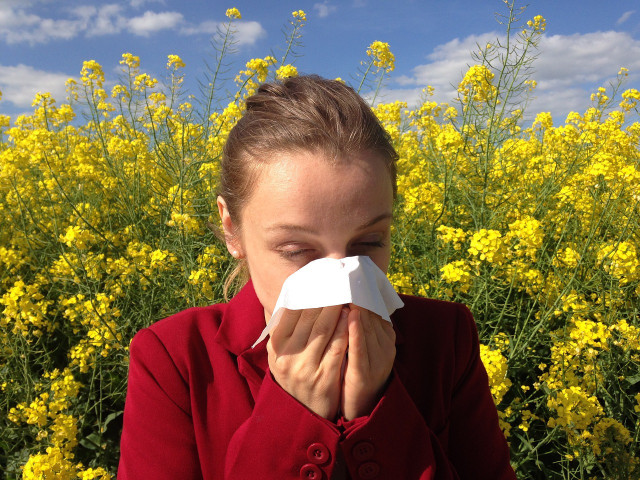With the warmer months comes higher pollen counts. But you don't need to suffer – here we'll show you some simple home remedies for pollen allergies.
Seasonal Allergic Rhinitis or pollen allergies (aka hay fever) is most common during the spring, summer and fall − and even in winter in some US states. Pollen allergies are caused by plants releasing tiny pollen grains to fertilize other plants of the same species. According to the Asthma and Allergy Foundation of America (AAFA) most of the pollen that causes allergic reactions comes from trees, grasses, and weeds. These plants make small, light, and dry pollen grains that are carried by the wind. This pollen can irritate the eyes, nose and lungs, causing discomfort for anyone with a mild or more severe pollen allergy.
What Plants Cause Pollen Allergies?

(Foto: CC0 / Pixabay / cenczi)
Tree Pollen Allergy
Tree pollen is the first pollen to appear each year in the US. It is responsible for most spring pollen allergy symptoms, but it often overlaps with grass pollen releases later in the spring and summer months. Trees normally produce the most pollen from mid-March through to May. In some southern states, these trees start to produce pollen as early as January and then multiple more times over the course of a year.
Tree species that cause the most allergy symptoms in the US are:
- Alder
- Aspen
- Beech
- Birch
- Cedar
- Cottonwood
- Elm
- Hickory
- Juniper
- Maple
- Mulberry
- Oak
- Olive
- Poplar
- Willow
Grass Pollen Allergy
Those who have a grass pollen allergy, depending on where you live, your symptoms can be more or less severe. In the northern U.S, grass pollen appears in the late spring and early summer, while in the south, these grasses constantly release pollen through all four seasons. In the US there are literally hundreds of types of grasses, but thankfully only a handful cause annoying and tiresome allergy symptoms.
The most common types of grasses that cause allergy symptoms are:
- Bermuda
- Kentucky
- Orchard
- Rye
- Sweet vernal
- Timothy
Weed Pollen Allergy
Weed pollen, and in particular ragweed, accounts for most of the allergic weed pollen reactions in the US, with the pollen appearing in late summer and the fall. Ragweed grows in 49 states and the pollen can even travel hundreds of miles thanks to wind currents, making it near impossible to avoid no matter where you live.
Aside from ragweed, the other common weeds that can cause allergic symptoms include:
- Burning bush
- Cocklebur
- Mugwort
- Pigweed
- Russian thistle
- Sagebrush
- Tumbleweed
Home Remedies For Pollen Allergies



(Foto: CC0 / Pixabay / meineresterampe)
Anyone who has suffered from even a mild pollen allergy will be all too familiar with the symptoms. The most common of these are:
- Runny or congested nose
- Constant sneezing
- Itchy feeling in nose, eyes, ears and mouth
- Red, watery, puffy, or swollen eyes
The good news is that there are some simple steps you can take as home remedies for pollen allergies to reduce these allergic reactions to pollen. If you’re lucky, they might even reduce or eliminate the need for over-the-counter or prescription medications.
- Limit your outdoor activities when pollen counts are high. This will cut down the amount of pollen allergen you inhale and help reduce your symptoms.
- Wear sunglasses and cover your hair when going outside. This will help keep pollen out of your eyes and hair.
- Change and wash clothes worn during outdoor activities.
- Keep windows closed during pollen season or peak pollen times.
- Use central air conditioning or air cleaners with a certified asthma & allergy friendly filter and/or HEPA filtration to reduce indoor airborne allergens.
- Shower before going to bed to remove any pollen from your body and keep it off your bedding.
- Wash bed sheets in hot, soapy water once a week.
- Limit close contact with pets that spend a lot of time outdoors.
- Dry your clothes naturally indoors, or with a dryer – avoid using outdoor lines.
- Watch pollen counts and forecasts and adjust your activities to reduce exposure on those days there is a high pollen count expected.
Read on:
- How to Boost Your Kids’ Immune System: 5 Healthy Tips
- How to Clean Air Naturally and Why Your Home Needs It
- How to Get Rid of Dry Cough: Natural Home Remedies
Important Information regarding Health-related Topics.
** Links to retailers marked with ** or underlined orange are partially partner links: If you buy here, you actively support Utopia.org, because we will receive a small part of the sales proceeds. More info.Do you like this post?








